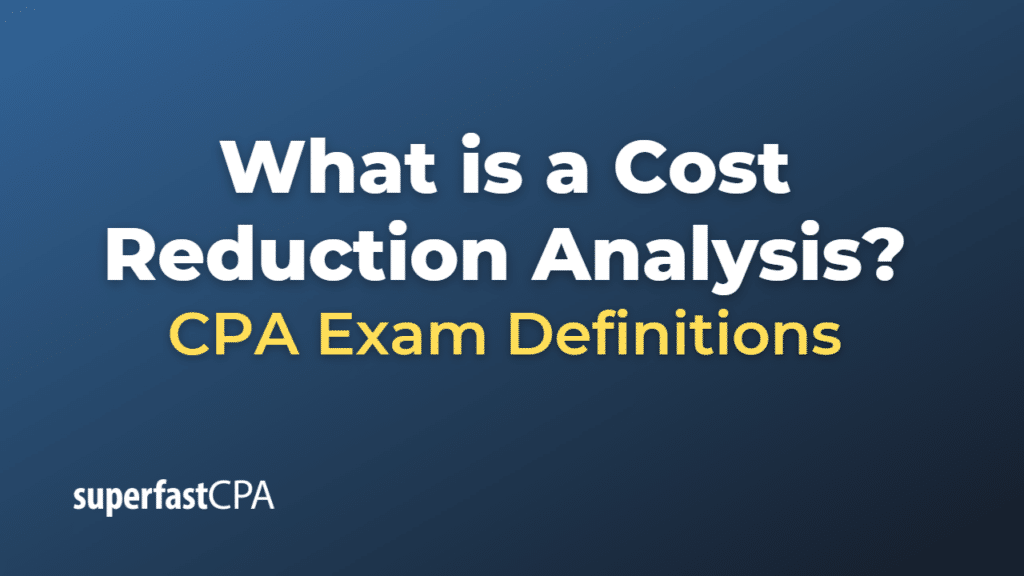Cost Reduction Analysis
A cost reduction analysis is a systematic process of identifying, analyzing, and implementing measures to decrease a company’s costs and improve overall efficiency. The goal of this analysis is to reduce expenses without sacrificing the quality of the products or services provided, ultimately leading to increased profitability and competitiveness.
Cost reduction analysis typically involves the following steps:
- Identify Cost Categories: Costs are classified into various categories, such as labor, materials, overhead, and fixed or variable costs, to better understand and manage the different types of expenses a company incurs.
- Measure Current Costs: Accurate data on current costs is collected, analyzed, and benchmarked against industry standards or historical data to identify areas where the company might be over-spending or under-performing.
- Identify Opportunities for Cost Reduction: Opportunities for cost reduction are identified by analyzing inefficiencies, waste, and redundancies. This might involve evaluating processes, renegotiating supplier contracts, implementing new technologies, or reducing non-value-adding activities.
- Evaluate Potential Solutions: The costs and benefits of each potential cost reduction measure are assessed. This might involve estimating potential savings, evaluating the impact on operations, and considering any risks or constraints associated with implementing the measures.
- Implement Cost Reduction Measures: The most promising cost reduction measures are selected and implemented. This could involve changes in processes, renegotiating contracts, or investing in new technology.
- Monitor and Evaluate Results: The effectiveness of the cost reduction measures is continuously monitored, and adjustments are made as necessary. This might involve tracking key performance indicators (KPIs), comparing actual results to projected savings, and identifying areas for further improvement.
A cost reduction analysis helps businesses stay competitive and maintain profitability, especially in challenging economic conditions or when facing increased competition. However, it’s essential to ensure that cost reduction efforts do not compromise the quality of products or services, as this could ultimately harm the business’s reputation and customer relationships.
Example of a Cost Reduction Analysis
Let’s imagine a company that manufactures bicycles is facing increased competition and wants to improve its profitability. The management decides to conduct a cost reduction analysis:
- Identify Cost Categories: The company identifies its primary cost categories, which include raw materials (metal, rubber, etc.), labor, manufacturing overhead (electricity, depreciation on machinery), and administrative expenses (office space, salaries of administrative staff).
- Measure Current Costs: The company collects data on its current costs in each category. For example, it finds that it’s spending $200 on raw materials, $100 on labor, $50 on manufacturing overhead, and $50 on administrative expenses per bicycle.
- Identify Opportunities for Cost Reduction: After analyzing its processes and costs, the company identifies several opportunities for cost reduction. It believes it can negotiate lower prices with its raw material suppliers, reduce energy consumption in its factory, and streamline its administrative processes.
- Evaluate Potential Solutions: The company estimates that by renegotiating with suppliers, it could reduce raw material costs by 10%, energy efficiency improvements could reduce manufacturing overhead by 20%, and administrative efficiencies could reduce administrative expenses by 15%.
- Implement Cost Reduction Measures: The company negotiates new contracts with its suppliers, invests in energy-efficient machinery, and implements new administrative software to streamline its administrative processes.
- Monitor and Evaluate Results: After implementing these measures, the company continuously monitors its costs. It finds that raw material costs have indeed reduced by 10% to $180 per bicycle, manufacturing overhead has reduced by 20% to $40, and administrative expenses have reduced by 15% to $42.50. Therefore, the total cost per bicycle has reduced from $400 to $362.50, a significant improvement in profitability.
This example illustrates how a cost reduction analysis can help a company identify, implement, and monitor cost-saving measures, leading to improved profitability.














